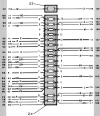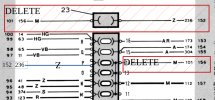Rod Midkiff
True Classic
I like the idea of doing both, and I often do when doing tail lights on a trailer.I don't agree. Yes, in theory you are correct - but in reality, a proper direct earth is lowest risk, highest reliability.
I like the idea of doing both, and I often do when doing tail lights on a trailer.I don't agree. Yes, in theory you are correct - but in reality, a proper direct earth is lowest risk, highest reliability.
Definitely. Lots of the little low current stuff will be fine if done properly via the monocoque. In the X where the battery is far removed from the starter/alternator, I reckon a decent lead, battery neg to starter earth gives an engine bay earth stud for key stuff with minimum loss. Well worth the effort and dare I say, weight!I like the idea of doing both, and I often do when doing tail lights on a trailer.


It would be easy to determine if a ground cable would make a significant improvement. All you need is an ohmmeter that has good accuracy and resolution for low resistance values. Measure the ground resistance between the two locations. Whether it is good enough will depend on your criteria for acceptable voltage drop (V=I * R). If it is not good enough, add a cable with low enough resistance to get you where you need to be.Regarding the additional ground cable idea. I see both sides of this; I agree with Dom that it really shouldn't be necessary, but I also agree that it certainly wouldn't hurt. The X does have a longer than usual distance between the battery and the major charging system components, but a short run to the main fuse/relay box. I suppose it may come down to personal preference, unless there is a specific need for it. For example on my current build I will be using a aftermarket standalone ECU to control the fuel and ignition. The instructions for that ECU highly suggest that you run a dedicated ground cable from the battery solely for the ECU. That might be a little overkill but they have their reasons for requiring it. Although for a stock vehicle with a electrical system in good condition, proper wire harness, clean ground connections, etc, I don't think there is any reason for a additional ground cable. But as I said earlier, it would not hurt anything other than adding weight. Perhaps adding a lighter medium-gauge cable (rather than a really heavy one) may be a decent compromise?
